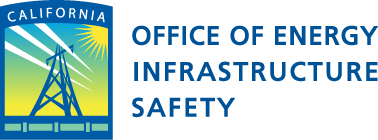Decision Moves to CPUC for Ratification
Since 2020, Energy Safety has pushed PG&E to implement important safety improvements related to risk modeling, vegetation management, system hardening in high-risk areas, and more
SACRAMENTO – The Office of Energy Infrastructure Safety (Energy Safety) today released its evaluation and final approval of Pacific Gas and Electric’s (PG&E) 2022 Wildfire Mitigation Plan (WMP) Update. Energy Safety’s approval of PG&E’s plan will go before the California Public Utilities Commission (CPUC) for ratification on a date to be determined.
“We are pushing PG&E to become a safer company by having a better understanding of their risk and implementing critical mitigations to reduce ignitions that cause catastrophic wildfire,” said Energy Safety Director Caroline Thomas Jacobs. “While we have seen improvement, PG&E must continue to grow and mature its ability to understand the consequence of its risk, adapt to climate impacts, and incorporate climate resiliency into how it safely builds, operates, and maintains the grid.”
Since 2020, through evaluation of PG&E’s annual WMPs and its compliance assurance activities, Energy Safety has:
- Matured Risk Modeling – Required PG&E to mature and evolve its understanding of wildfire risk modeling, year-over-year, incorporating the location and likelihood of ignitions, outages, and the consequence to infrastructure and customers.
- Directed Enhanced Vegetation Management in Highest Fire Risk Areas – Ensured that PG&E conducted its Enhanced Vegetation Management (EVM) activities in the highest fire risk areas through corrective actions and audits.
- Prioritized System Hardening Targets in High Fire Risk Areas – Required PG&E to plan system hardening work on the highest risk circuit segments. Since 2020, PG&E has increased the percentage of system hardening miles in the highest risk areas. From 2022 to 2026, PG&E estimates that 88 percent of its undergrounding projects will be focused on the top 20 percent of high risk-ranked circuit segments.
- Expedited Expulsion Fuse Removal – Required PG&E to increase its expulsion fuse (known to cause sparks that create ignitions) removal efforts. PG&E’s 2021 goal of 1,200 expulsion fuses removed has increased to a goal of 3,000 removed for 2022.
- Required a Repair Backlog Clearance Plan – Required PG&E to develop and implement a plan to clear its repair backlog. As a result, PG&E restructured its field safety assessment process to stop resetting repair due dates and focus on closing out inspection findings, especially in the highest priority risk areas.
- Required Improved Recordkeeping and Asset Inventory – Required PG&E to improve and consolidate its vegetation management systems, streamline its records management process, and improve its asset inventory information.
- Conducted Inspections and Corrective Actions – Completed more than 10,000 inspection activities on PG&E infrastructure and equipment and directed corrective action on more than 200 PG&E defects and violations.
- Performed Audits – Issued a Substantial Vegetation Management (SVM) Audit of 2020 vegetation management activities and directed corrective action on 12 findings.
- Required Joint Effectiveness Studies – Required PG&E (with Southern California Edison and San Diego Gas & Electric) to conduct joint effectiveness studies on both Enhanced Vegetation Management (EVM) practices and the installation of covered conductors to assess the risk reduction benefit and inform the development of consistent practices.
In May, Energy Safety issued a revision notice to PG&E, requiring the electrical corporation to satisfactorily address issues with its initial 2022 WMP Update submission. In October, Energy Safety published its draft decision on PG&E’s 2022 WMP Update that allowed for public review and comment.
In addition to PG&E, 2022 WMP Updates have been approved for San Diego Gas and Electric, Southern California Edison, Liberty Utilities, Horizon West Transmission and Trans Bay Cable. The remaining 2022 WMP Updates for Bear Valley Electric Service and PacifiCorp are currently published as draft decisions to allow for public review and comment before a final decision.
Legislation signed into law in 2019, after a series of devastating wildfires, requires California’s eight electrical corporations to assess their wildfire risk, propose actions to reduce that risk, and prevent catastrophic wildfires caused by their infrastructure. They must produce and submit three-year Wildfire Mitigation Plans, updated every year, for Energy Safety’s evaluation. The plans follow a set of guidelines developed annually by Energy Safety. Once the plans are approved, they go to the CPUC for ratification.
Energy Safety became an independent department under the Natural Resources Agency on July 1, 2021. Between January 2020 and July 2021, Energy Safety was known as the Wildfire Safety Division within the CPUC. This is the third year that the electrical corporations have submitted wildfire mitigation plans, or plan updates, for evaluation.

